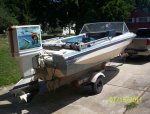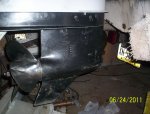I "inherited" a early 70's 45hp Chrysler last year from a guy who said it "ran great." It did well for the first few trips (short runs to a fishing spot) and then it went nuts. The best way to descibe it is that while running full throttle on mild(ish) water the sound of the motor would race into a high-winding pitch (like a chainsaw or something). I quickly would back off of the throttle and baby it for awhile. (I can't say that it lost thrust until I back off.) The problem occurred several times so I asked around for advice.
This advice led me to taking the L/U off to find the gears in terrific shape. It was resealed and reinstalled. It ran strong and then...rrrwwwaaaahhh - running wild again!
It seems when the river's flat, I can ease up to full throttle and it runs stong. When I hit choppy water, off it went again.
Any thoughts? I'm afraid of causing (more?) damage if it continues.
This advice led me to taking the L/U off to find the gears in terrific shape. It was resealed and reinstalled. It ran strong and then...rrrwwwaaaahhh - running wild again!
It seems when the river's flat, I can ease up to full throttle and it runs stong. When I hit choppy water, off it went again.
Any thoughts? I'm afraid of causing (more?) damage if it continues.





















